 Sunday/Weekend
Sunday/Weekend

 |
| The Vĩnh Hưng Tower ruin, a Special National Heritage site and the last vestige of the Óc Eo Culture in Vĩnh Lợi District, Bạc Liêu Province. – VNA/VNS Photo Chanh Đa |
The Vĩnh Hưng Tower ruin in the Mekong Delta Province of Bạc Liêu is the last vestige of the Óc Eo Culture (1st to 8th centuries) in southwest Việt Nam.
Named after its location in Vĩnh Hưng Commune in Vĩnh Lợi District, it was recognised as a "National Architectural Heritage site" by the Ministry of Culture, Sports, and Tourism in 1992, and as a "Special National Heritage site" this year by the Government.
According to experts, its architecture is unique and has many differences from the Champa towers found in central Việt Nam.
It lacks the characteristic stepped levels, pillars, false columns, decorative patterns on the exterior, and false doors.
A particularly rare feature in religious architecture of ancient cultures influenced by Indian civilisation is that the tower's entrance is not oriented to the east but instead faces southwest.
It is square with chamfered corners in the front and back and three symmetrical chamfers in the front and back.
The tower is large measuring 9.44m by 9.36m at the base with a height of nearly 10 metres, and has thick brick walls that support a load of several thousand tonnes.
Its foundation is broad on an area of nearly 100sq m, and was built with alternating layers of stone and brick, a design that helps prevent its subsidence on what is weak ground, and resulting in just slight settling after thousands of years.
Inside the tower is a symbolic linga and yoni, the origin of all creativity in the Óc Eo culture.
In Óc Eo religion, holy water used to bathe the linga and yoni was sprinkled over people for good health, prosperity, fertility, and abundant offspring.
The ancient tower was discovered in 1911 by French scholar Lunet de Lajonquière, who named it Trà Long Temple.
In 1917 French archaeologist Henri Parmentier surveyed the site and renamed it Lục Hiền Tower in the Bulletin of the French School of the Far East.
Until 1990 archaeologists from the Institute for Southern Regional Development and the Minh Hải Province Museum (now Bạc Liêu and Cà Mau provinces) conducted surveys and excavated a test pit.
They discovered artefacts such as a deity's head, a grinding table and linga and yoni structures, and dated the tower to the 7th-8th centuries, the late phase of the Óc Eo Culture.
In 2002 and 2011 the Archaeological Research Centre collaborated with the Bạc Liêu Museum to excavate the area surrounding the temple ruin, uncovering numerous artefacts, including bronze statues, stone lingas and ancient tiles and bricks.
.jpg) |
| Some of the artefacts found around the Vĩnh Hưng Tower ruin are on display in the exhibition hall at the site. – VNA/VNS Photo Chanh Đa |
Five of them have been recognised as national treasures, including a statue of Goddess Lakshmi, a statue of God Sadashiva, a head of Shiva, a statue of a male deity, and a bas-relief of Goddess Uma.
The artefacts are preserved at the site’s exhibition hall.
 |
| The back of the Vĩnh Hưng Tower ruin. – VNA/VNS Photo Chanh Đa |
Bạc Liêu authorities are planning upgrades and further excavations of an area covering three to five hectares at the Vĩnh Hưng Ancient Tower site. VNS